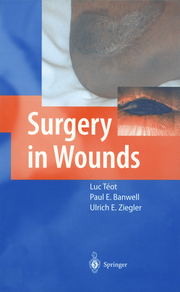Detailansicht
Surgery in Wounds
ISBN/EAN: 9783642639296
Umbreit-Nr.: 5652121
Sprache:
Englisch
Umfang: xiv, 554 S., 162 farbige Illustr., 554 p. 162 illu
Format in cm:
Einband:
kartoniertes Buch
Erschienen am 30.09.2011
Auflage: 1/2004
- Zusatztext
- Wounds have existed since the beginning of time, and records of their nature and treatment are found in the earliest documents. Interestingly, many of these treat ments are now being rediscovered or re-used in modern-day clinical practice. In addition to the diverse nature of treatments that have been suggested as being beneficial for wounds, over many centuries there has been a range of clinicians who have cared for patients with wounds, and in many parts of the world today it is not doctors but other professional colleagues - e. g. nurses or podiatrists - who are the most knowledgeable persons on wounds and wound treatments. Finally, the nature of wounds seen in clinical practice is changing. Increasing destructive power is resulting in more severe injuries occurring in patients involved in conflict. Developments in surgical techniques have enabled new surgical procedures to be offered to patients, but novel and more severe complications can result from such technical advances. In addition, many societies around the world are having to deal with an increasing ageing population, and huge increases in the number of patients suffering from chronic wounds are being seen. In summary, expanding treatment options, diverse groups of clinicians caring for patients and changes in the nature of wounds seen in clinical practice are real issues that have to be faced, and solutions have to be found if patients are to receive optional care for their wounds.
- Kurztext
- The management of wounds poses a considerable challenge for clinicians. It is with great pleasure that we therefore introduce 'Surgery in Wounds' to the wound healing fraternity to convey some important surgical perspectives and philosophies that are utilised when dealing with an array of difficult wounds. There is no doubt that our improved understanding of wound healing biology and new technologies will continually influence clinical practice. Traditionally, reconstructive surgeons have adopted a one-stop surgical approach for the closure of wounds over the last few decades using flap surgery as the cornerstone of their armamentarium. However, alternative and adjunctive solutions are now being developed which offer a new staged approach to wound management. In particular, we must embrace these ideas into surgical practice as well as integrating ideas from across all surgical disciplines. This book brings together a veritable wealth of surgical experience and reflects practice on a global scale. It explores many avenues: from basic concepts to advanced reconstructive procedures. We hope that this may expose the reader to new ideas and generate the enthusiasm and desire to apply these lessons to their own clinical practice. There are two kinds of knowledge: that which we already know, and that which we know where to find. 'Surgery in Wounds' offers an opportunity to find such knowledge readily and we hope will be a welcome addition to the libraries of individuals and institutions alike.
